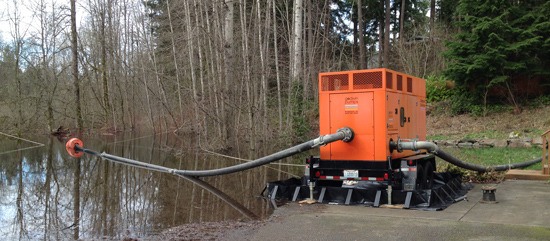It’s looking like Bonney Lake has a handle on the flooding that has plagued some city residents for the past couple months.
Residents along 62nd Street behind Lakeridge Middle School started noticing at the end of December that rain water wasn’t draining back into the ground like in previous years.
What started as a few inches of water on the road at the end of December turned into as much as 4 feet by February, making vehicle access to some homes impossible and disrupting mail and waste services.
The city started pumping water out of the flood basin and into Lake Tapps around the clock Feb. 22. The 6-inch pump moves approximately 1,000 gallons of water every minute.
After pumping for five days straight until Friday, Feb. 26, the water level dropped 1.29 feet, which was more than City Engineer John Woodcock estimated would happen.
Woodcock said there is still water on the intersection of 188th and 62nd and 187th, but he mentioned that 185th street was now clear and completely accessible.
It helped that the weather in Bonney Lake remained fair throughout the week and didn’t add any rain water into the basin, Woodcock said.
And despite the half inch of rain the city received over the weekend, the water level did not increase when the city checked the morning of Monday, Feb. 29.
As of last Friday, the city decided to continue leaving the pump on for 24 hours a day from Monday, Feb. 29 to Friday, March 4 to try to bring the water level down another foot. At that point, Woodcock explained, the city will decide whether or not to continue 24 hour pumping or bring it down to only pumping during the day.
With the water situation seemingly under control, Woodcock said the city is no longer considering renting pedestrian bridges to help residents cross the flood water.
“We seem to have the answer here. We just have to stick with it,” he said.
After the water is gone and the rainy season is over, Woodcock said he would like to perform some infiltration tests on the ground in the flood basin to figure out why the water wouldn’t seep back into the ground like it did in the past.
“You really want to have a year or two of data to see if this is a once in 20-year thing, or an every year occurrence,” Woodcock said. “This can only happen as time goes by… But we’re just not there yet.”
The flood basin flooded once back in 1996, but that was caused by a snowstorm followed by warm rain, which melted the snow faster than the ground could absorb it.


